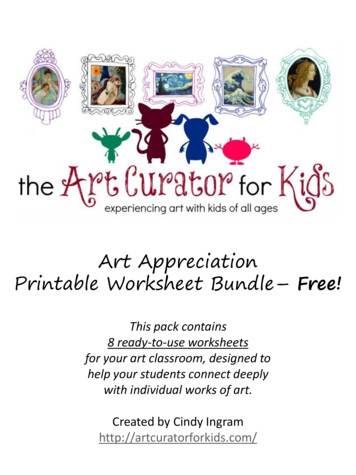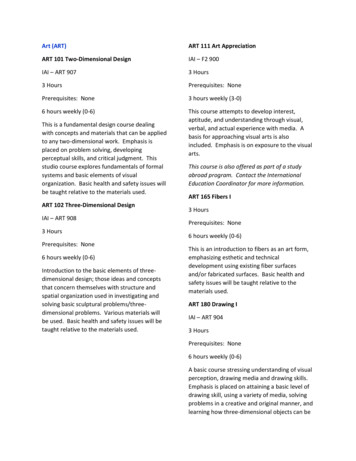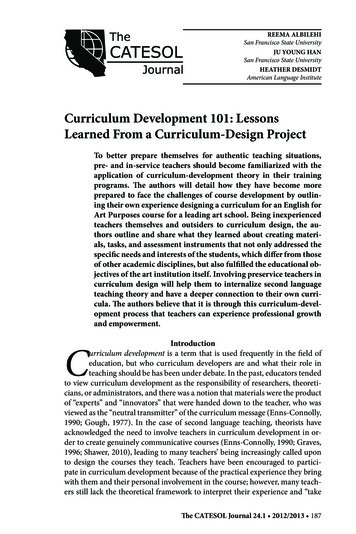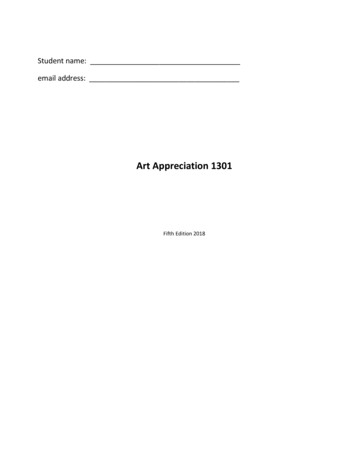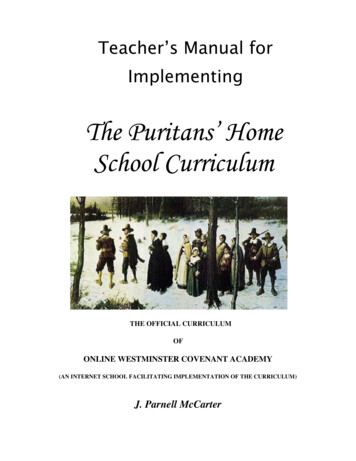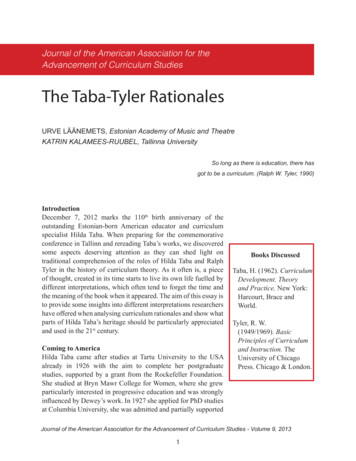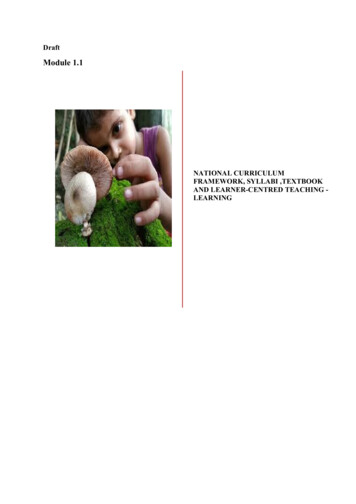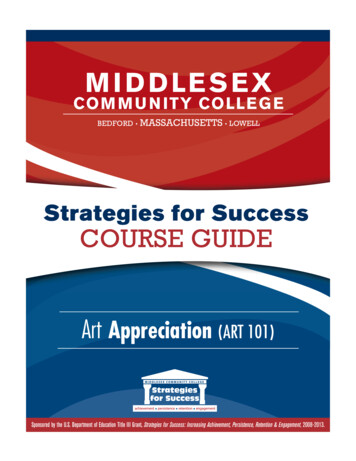
Transcription
M I D D LE S E XCOM M U N ITY COLLE G EBEDFORD MASSACHUSETTS LOWELLStrategies for SuccessCOURSE GUIDEArt Appreciation (ART 101)Sponsored by the U.S. Department of Education Title III Grant, Strategies for Success: Increasing Achievement, Persistence, Retention & Engagement, 2008-2013.
Title III Strengthening Institutions ProjectStrategies for Success: Increasing Achievement,Persistence, Retention and EngagementThe Strategies for Success Title III initiative is a major, five‐year project (2009‐2013) funded bya two million dollar grant from the U.S. Department of Education. This initiative is intended totransform Middlesex Community College by improving the academic achievement, persistence,retention, and engagement of its students.The project focuses on reformed curricula and comprehensive advising. Reformed Curriculuminvolves the design of developmental and college Gateway courses and learning communitiesembedded with Core Student Success Skills related to critical thinking, communication,collaboration, organization, and self‐assessment. Overall, 45 courses will be impacted over thefive years of the project. Comprehensive Advising involves the design of integrated advisingservices to include identification of academic and career goals, creation of realistic educationalplans, and continuous tracking and intervention with an emphasis on the Core Student SuccessSkills. Comprehensive Advising Services will be specifically tailored to each program of study.Cross‐division curriculum and advising design teams composed of faculty and staff aredesigning, piloting, and assessing the curriculum and advising initiatives.The Title III grant provides resources to support faculty professional development related todesigning and piloting new curriculum and advising students. The grant also supports thepurchase of advising software programs and the hiring of a Pedagogical Instructional Designer,Learning Engagement Specialist, Advising Coordinator, and two academic advisors. Theresources provided by the grant offer an exciting opportunity for the college community towork together to develop the strong programs and services that will increase student success.
1ContentsIntroduction . 2Lesson Plan: Selective Perception. 4Lesson Plan: The Visual Elements‐‐Line and Value. 6Lesson Plan: Space and Time Represented on the Picture Plane. 10Lesson Plan: Introduction to Photography . 12Lesson Plan: Architecture‐Form, Function, and Expression . 14Lesson Plan: Comparison of Style ‐ Classic vs. Romantic. 16Lesson Addendum Material. 17Lesson Plan: Group Presentation Assignment – The “Isms” in Late 19th and 20thCentury Western Art. 18Lesson Addendum Material. 20Lesson Plan: Art and Culture Local Impact . 23Lesson Addendum Material. 25Lesson Plan: Public Art Controversy . 26Lesson Addendum Material. 28Handout: Discussion Questions . 29Lesson Plan: Renaissance Innovations Activity. 31Lesson Plan: Visual Elements‐Design decisions artists make . 34Lesson Addendum Material. 36Handout: Tips and Examples for writing the essay(s). 38Lesson Plan: Team Multimedia Presentation . 39Lesson Addendum Material. 41Sample Syllabus: Instructor Margaret Swan. 47Sample Syllabus: Instructor Margaret Rack. 53
2IntroductionART 101 Art Appreciation is a college‐level course that focuses on developing students’visual acumen, aesthetic insight, and knowledge of the forms and role of art across timeand cultures.As a result of a Title III grant, Strategies for Success: Increasing Achievement,Persistence, Retention and Engagement, this course has been designed to incorporatethe following Student Success Skills (CSSS): Critical Thinking, Communication,Collaboration, Organization and Self‐Assessment. The concept is to lead students toapply these skills as a method for learning course content. The expectation is that bypracticing these skills in this course, they will develop into more successful collegestudents overall, and as a result, persist in their college studies. We have expanded thecommon definition of these skills to reflect the disciple of visual art as noted in theunderlined phrases: Critical Thinking includes the ability to use and analyze information gatheredfrom multiple sources and form conclusions based on evidence rather than assumption. Communication skills can include the ability to write, speak, design and presentvisual material (making art as well as making multimedia presentations) and usetechnology effectively. Collaboration includes participating as a member of a community, either as partof a group of students in the class, and/or a group of people outside of the classroom. Organization skills related to organizing a hierarchy of information – visual aswell as written‐‐and to time management, note‐taking, test‐taking, and studying areimportant for success in college. Self‐Assessment skills include setting academic and career goals, developing andfollowing a plan to achieve those goals and utilizing college resources to help studentsachieve their goals.Majors in Studio Art, Graphic Design and Early Childhood Transfer are required to takeArt Appreciation. Students vary widely in their interests, knowledge and abilities inapproaching the course content as well as their success skills. This guide was designedto provide a variety of lesson plans that advance subject knowledge, develop students’ability to think critically, and lead students to apply success skills while meeting rigorouscollege‐level standards. It is based on a 16 week semester, with classes meeting twiceper week for 75 minutes. Lesson plans are organized in units that provide proceduresfor a single class, and may link several classes to accomplish the learning objectives.
3Sample handouts and assignments are included as well as copies of syllabi for theredesigned fall 2011 course.We hope the guide proves useful to both new and experienced instructors looking forideas and approaches to develop student success skills within their own courses. Ourintention was to provide a sufficient range of examples to enable the reader to get anunderstanding of our approaches in both practical and theoretical terms. We acceptthat there are many ways to approach teaching Art Appreciation, and each faculty willdesign what is suitable for their circumstances. A selection of lessons presented, forexample, take advantage of the museums, galleries, art studios and public art withinwalking distance of the Lowell campus. Instructors are welcome to use these lessons orto design their own in response. We invite your feedback, questions, and comments;contact either Marge Rack at rackm@middlesex.mass.edu or Margie Swan atswanm@middlesex.mass.edu
4Lesson Plan: Selective PerceptionAuthor: Margaret SwanSuggested Time Frame: 30 minutes – introduction and small group analysis1‐2 hours – creation of “vanitas” collage for homework40 minutes – presentation of collagesLearning Objectives: After successfully completing this activity, students will be able to:: Investigate the process of looking itself – to notice details and visualrelationships.Explain the subjective nature of perception.Analyze visual relationships in art as a way to understand meaning andexpression.Core Student Success Skills Addressed:Communication, Collaboration, Critical Thinking, OrganizationMaterials: Large, high quality projected image of this painting:Figure 1: Audrey Flack, Wheel of Fortune, 1977, oil on canvas, 8x8’Context within Course:This multi‐part project is presented early in the course to help students becomeacquainted with each other and their subjective responses to art.
5Instructions:1. Having assigned related reading from the text, explain the relationships ofperception to culture, past experience, knowledge, etc.2. To fully experience selective perception, ask students to study the details ofAudrey Flack’s painting for 30 seconds or so. Remove the image and have themmake a list of all of the objects they saw.3. Working in groups of three, students compare their lists of objects. Have themdiscuss and note factors that made some objects more memorable‐‐like color,lighting, size, or position in the painting. Then ask students to consider whethercertain objects were recalled, because they were more familiar or more part oftheir environment.4. Project image again and then explain the theme of “vanitas” in art. Have eachgroup compile a list of the objects that refer to life, time, chance, personalvanity, and death. After completing their list, have one student write down thegroup’s interpretation of the painting. Another student presents the group’sthoughts to the class. All notes and reflections are collected for assessment.5. Explain homework project: Create a “vanitas” collage, drawing, painting, photo‐montage, or assemblage that presents similar ideas or questions about life, time,and death as the work of Flack.6. Exhibit the “vanitas” works in the beginning of the next class and discuss theideas and viewpoints that they communicate. Each student will explain theirinterpretation of the assignment to the class.Assessment:The notes and reflections of each group are collected and assessed by their degree ofengagement. The homework projects are assessed for their thoughtful and fullydeveloped interpretation of the theme. (Talent or previous art experience is notrequired to produce a successful project.)Optional Activities:Research other artworks that have interpreted the vanitas theme throughout history.
6Lesson Plan: The Visual Elements‐‐Line and ValueAuthor: Margaret SwanSuggested Timeframe: 75 minutesLearning Objectives: After successfully completing this activity, students will be ableto:: Identify line and value as symbols of perception and expression in 2D art forms. Analyze the formal and expressive aspects of the visual elements to furtherenjoy and understand works of art.Core Student Success Skills Addressed:Critical Thinking, Communication, and OrganizationMaterials: Presentation of a diverse body of slides of drawings, paintings, and prints thatillustrate line and value as the key elements that convey unity and meaning tothe viewer. (I recommend ARTStor Digital Library at www.artstor.org as sourcefor images.) Large roll of white paper, tape, and markerContext with the Course:This learning‐to‐see lesson is presented early in the course to provide the underpinningsof the language of art. Students have been assigned to read the section online and valuein their text.Instructions:1. Use slide presentation to introduce the concepts of the power of both actual andimplied lines to convey boundaries, contour, direction, movement, emphasis,and expression.2. The images presented are the basis of a series of posed questions to elicitresponses from the class as they learn as a group to see the compositionalchoices of the artists.Example of a painting with expressive line quality:
7Figure 2: Mark Tobey, Broadway, 1936, temperaWithout announcing the title, ask students questions. Based on their answers, ask a lotmore questions: What is the subject? Exactly, where is this? How do you know? Besides the billboards, what aspects of the lines let you know this is TimesSquare? How would you characterize the line quality? How is this movement conveyed? What do the white lines on dark ground suggest? Is there order in this chaos?Where does your eye go? Is there a focal point? Etc.Selecting an accessible image that students can easily decipher creates a sense ofsuccess in their ability to “read” an image.3. Continue with question‐and‐answer format as additional slides are projectedthat address other approaches to line, such as implied lines. Then have themanswer the questions by drawing diagrams on their paper, as well as on papertaped to the projection screen. Ask students to compare their diagrams withanother student.
8Figure 3: Example of implied lines: Peter Paul Rubens, Descent from the Cross, 16124. Without announcing the title, ask students to draw the major implied line ontheir paper. Walk around and see what they have drawn and then ask if thediagonal line is going up or down.Explain the subject of the painting and then ask more questions that refer to theintention of the artist: What is generating the other implied lines? Are there glances, gestures, or interesting connections between points thatcreate directional lines? How do these lines unify the painting? Do these lines help to convey meaning or expressive content?5. Introduce the visual element of value in the same manner. Select images thatemphasize a strong sense of chiaroscuro, such as Baroque paintings, to start thequestion‐and‐answer process. (The Rubens painting illustrates this as well.)6. Select an expressive painting for students to analyze as a small group of three.Have each group draw a diagram and label keys elements, such as the focalpoint, and create a list of feelings or ideas that are emphasized by the light anddark contrast.Assessment:Informal assessment will occur through the class discussion and the diagrams studentsproduced individually and in groups. Formal assessment will occur in the following class
9when students diagram and analyze a painting in essay form that they haven’t seenbefore.Next Steps/Optional ActivitiesTo prepare for the writing assignment in the following class, students will review theconcepts of line and value by accessing their www.artstor.org folder that will containimages that they can analyze independently.
10Lesson Plan: Space and Time Represented on the Picture PlaneAuthor: Margaret SwanLearning Objectives: After successfully completing this activity, students will be ableto:: Demonstrate an understanding of methods to create illusions of 3D space on a2D surface. Analyze the relationship of space and time to the artist’s intention and meaning.Suggested Timeframe: 1½ 75‐minute classesCore Student Success Skills Addressed: Critical Thinking, CommunicationMaterials: Presentation of slides of paintings from varying times and cultures that highlightunique characteristics of time/space relationships, such as Byzantine icons,Chinese landscapes, Persian miniatures, Renaissance perspective, Cubistinteriors, Futurist figures, and modern interpretations, such as David Hockney(artstor.org). Handout of linear perspective diagrams and photo collage illustrating multipleviewpointsInstructions:Note: Slide Presentation is in the form of an active question‐and‐answer format. Use atechnique that requires full engagement. (Pull names out of a hat, etc.)1) Introduce implied space‐ ‐suggesting depth in two dimensions‐‐beginning withoverlapping and position in picture plane.2) Continue with in‐depth explanation of linear perspective – horizonline, vanishingpoint, single moment in time, etc.3) Take class in the hall and have them experience the concepts by sitting on floor,standing on a chair and viewing the converging parallel lines of the ceiling, floor, etc.4) Back in‐class, continue with foreshortening (demonstrate with finger) andatmospheric perspective. Show many examples that highlight this phenomena’s effecton contrast, color, and texture.5) Explain isometric perspective – Chinese, Persian painting and modern uses in design.6) Introduce concept of multiple viewpoints – refer to handout and start with Cezanne,move into Cubism, Futurism, modern examples.
117) Explain the homework project: Create a photo collage that creates a Cubist or Futuristapproach to space and time. Show example of Hockney’s Scrabble Game for inspiration.8) Exhibit the collages in the beginning of the next class and have students discuss theirinterpretations.Assessment:The homework projects are assessed for their thoughtful and fully developedinterpretation of the concept. Also, a comparative essay question that contrasts the useof space and time in two projected paintings will be included on the exam.Talent or previous art experience is not required to produce a successful project.
12Lesson Plan: Introduction to PhotographyAuthor: Margaret SwanSuggested Time Frame: 75 minutesLearning Objectives: After successfully completing this activity, students will be ableto:: Demonstrate and explain the image transferring property of light. Explain the relationship of photography to other art forms.Core Student Success Skills Addressed:Critical Thinking, CollaborationMaterials: Digital images of photographic history and examples of photography as a fine artform – camera obscure, daguerreotype, etc Pinhole camera (flour canister, shoe box) Photographic paper Full darkroom – assistant desirable for quick turn aroundContext within the Course:Part of a unit on art media – mid part of the course.Instructions:1. Begin with explanation of the camera obscura. Show examples of acontemporary approach with this concept – Abelardo Morrell. Contrast his longexposures to the stroboscopic images of Harold Edgerton.2. Take class outside and have a student take a picture with our pinhole camera(flour canister has photographic paper inside already). Another student timesthe exposure based on available light.3. Bring class into darkroom and explain the development process. Studentremoves paper from canister and develops print.4. Explain the photogram, a technique that does not require a camera. Studentspair up in front of each enlarger and create a composition with whatever is intheir pockets on top of the provided photographic paper on the enlarger’s easel.They turn on the enlarger for a few seconds and expose their paper.5. After developing their image, they create another one further exploring thevariety of ways to control light to create an exciting composition.6. Students return to class while their prints are drying and brief photographichistory presentation resumes.
137. Introduce photography as an example of a basic truth: “Artistry resides not in thehands but in the head.” Present a wide range of black‐and‐white photographsthat highlight the expressive aspects of point of view, value, space, contrast, etc.in order to highlight photography as a fine art form. Ask students to identifythese aesthetic choices and their effect on the content of the photographs.8. If everything goes together as planned, darkroom assistant delivers the printsbefore the end of class. We view the results and they can take them home.Assessment:Elements of this class will be assessed by an essay question on their exam.Optional Activities/ Extra Credit:Students are offered the opportunity to borrow the pinhole camera, or make onethemselves and produce several photographs. Students may also create photogramsduring open lab hours. Darkroom assistant will provide paper and support.Note: Although students carry sophisticated camera phones in their pockets, they aremystified by the magic of the simple pinhole camera.
14Lesson Plan: Architecture‐Form, Function, and ExpressionAuthor: Margaret SwanSuggested Timeframe: 75 minutesLearning Objectives: After successfully completing this activity, students will be able to: Demonstrate knowledge of the operational, environmental, and expressivefunctions of architecture. Explain the concept of “form follows function” in regards to architecturaldesign. Experience the complexities and evolution of the design process. Work as a team to solve a problem. Demonstrate knowledge of the hierarchies of information.Core Student Success Skills Addressed:Critical Thinking, Communication, Organization, CollaborationMaterials: Examples of well designed functional objects, such as spoons Architectural images that convey the conceptsContext within Course:This is an introductory class session on architecture that is followed by classes onarchitectural design elements and structural relationships.Instructions:1) Introduce the concept of “form follows function” by analyzing simple utilitarianobjects, such as a variety of spoons – teaspoon, soupspoon, ladle, etc. Askseemingly juvenile questions: What forms do they share? What determines thesize and shape of the handle and bowl? Are there aesthetic choices as well? Etc.?2) Ask students to give other examples of other objects that exhibitinterdependent relationships between aesthetic value and usefulness (airplane,bow of a boat, car, coffeemaker).3) Explain concepts of operational, environmental, and expressive functions ascontributors to the resolution of an architectural design.4) Breaking into groups of three, explain the concept for this activity: Imagine youare an architectural team and you are interviewing the planning committee forthe redesign of the MCC Bedford campus from its original function as aseminary.5) Take architectural teams outside and point out original buildings and layout.Explain history of the site. Answer questions that arise.6) Directions for each group:
15a. Create a list of questions that you will ask the planning committee todetermine the design of the new campus. Group your list of questionsinto three sections that correspond to the functions of architecture. Bethoughtful and probing, particularly in regards to the expressive orsymbolic functions of the campus design.b. After compiling a list of questions for the planning committee, imaginethe answers they would have given to your questions, based on theappearance of the campus today. You may need to go outside again andstudy the relationships of the buildings to each other in order to answeryour questions. Make a corresponding list of answers next to yourquestions.c. Reflecting on your responses, create a summary of your impressions ofthe campus design. Do you think it is successful? Why or why not? Whatmessage does it project to students and the college community?d. Present your ideas to the class.Assessment:Each group will submit their questions, answers, and summaries for evaluation.Students will be graded on the depth of their investigation into the question‐and‐answer process.Next Steps:Ask students if they see similarities of this process in another course they have taken.Graphic Design students should immediately make the connection, but try to makeassociations in other disciplines as well.
16Lesson Plan: Comparison of Style ‐ Classic vs. RomanticAuthor: Margaret SwanSuggested Time Frame: 75 minutesLearning Objectives: After successfully completing this activity, students will be able to: Compare and contrast works of art through visual analysis. Explain the effect of an artist’s style on the meaning and expressive content.Core Student Success Skills Addressed:Critical Thinking, Communication, CollaborationMaterials: Large, high quality images of Leonardo and Tintoretto’s paintings of The LastSupper Handout with viewing questionsContext with the Course:Working in small groups, this activity gives students the opportunity to analyze conceptspreviously presented concerning the artist’s intention and the evolution of style.Concepts regarding idealism versus realism, and classicism versus romanticism, havebeen discussed already. Students have read chapters on Classical Greek and Hellenisticsculpture and Italian Renaissance art.Instructions:After studying classic and romantic stylistic trends in art history, starting with Greeksculpture, this comparison of two paintings of the same subject, The Last Supper,interpreted in different styles, will highlight the relationship of form and content.1) Working in groups of three, students will study projected images of Leonardo andTintoretto’s paintings of The Last Supper and complete a comparison of the paintingstogether.2) Students will be guided in their observations by answering the questions on theaccompanying handout.3) Each group will present a summary of their interpretation to the class.Assessment:Students will be graded on their thoughtful responses to questions on the handout.
17Lesson Addendum MaterialAnalysis of Leonardo and Tintoretto’s The Last SupperThe Last Supper depicts the final gathering of Jesus Christ with his disciples before Jesuswas brought to trial and crucified. These two paintings convey different moments andinterpretations of this sacred Christian event.These questions will guide your group to consider the many ways the artists use thevisual elements to convey their message. Answer the questions onlined paper.Questions 9 and 10 will help you to summarize your interpretations of the paintings.Each group will present their summary to the class and hand in the answers to thequestions. You will be graded as a group on the degree of completeness of your analysis.1. Explain the use of linear perspective in each painting?2. Where is the vanishing point? Focal point?3. Explain the use of implied lines in each painting?4. Explain the division created by the table in each painting?5. Explain the use of movement in each painting?6. Describe the use of light and dark contrast?7. Describe color relationships in each painting?8. Which painting is more complicated in its composition? Explain.9. After reviewing questions 1‐8, which painting is a more classic statement of the eventand why?10. Which painting conveys a stronger sense of emotion and why?
18Lesson Plan: Group Presentation Assignment – The “Isms” in Late 19thand 20th Century Western ArtAuthor: Margaret SwanSuggested Timeframe:3 periods of 75 minutes for group work, 2 periods of 75 minutes for presentationsLearning Objectives: After successfully completing this activity, students will be able to: Research a topic and determine the main ideas. Organize information and corresponding images for presentation. Create an outline to serve as a study guide for the class. Explain the relationship of artistic styles to one another.Core Student Success Skills Addressed:Communication, Collaboration, Critical Thinking, Organization, Self ReflectionMaterials: Computer lab for group work Handouts: Project Directions, Rubric, Self‐AssessmentContext with the Course:This is a capstone project for the class.Instructions:1. Assign students into groups of three. Try to balance groups with Art and Designstudents mixing with other majors. Also try to balance skill sets as best aspossible.2. A representative of each group selects an envelope out of a hat that contains thename of the style, such as: Impressionism, Post Impressionism,Fauvism/Expressionism, Cubism, Bauhaus/DeStijl, Dada/Surrealism, AbstractExpressionism, Pop, and Minimalism. There are usually 8‐9 groups.3. Fully explain the project directions and rubric, emphasizing that students will beteaching each other the content of their upcoming exam. This will require themto focus on the main ideas to create a presentation that will be engaging andinformative.4. Student groups map out their responsibilities for researching their topic.5. Next two classes meet in the computer lab and students refine their researchand assemble their presentations. Meet with groups individually to check theirprogress, understanding of the topic, and the representative artists selected.
196. Students email their group’s study guide and copies are made for each student inthe class.7. Groups give their presentations during last two classes. There is also time tocomplete a self‐reflection paper and to discuss strategies to prepare for theexam.Assessment:The exam is a compilation of the major ideas from the groups’ presentations. Somequestions are based on viewing images of artwork that was presented. An essayquestion is included that requires them to relate their group’s style to another onepresented.
20Lesson Addendum MaterialSelf‐Reflection of Group Presentation1. How would you evaluate your presentation in relation to the other groups?2. What aspect of your presentation was the most successful?3. What aspect of your presentation could be improved?4. Describe how your group worked together as a team.5. Were there problems working on the group project?6. What should be done differently in the group project next term?
21Rubric for ISM Group PresentationsISM: Group MembersPossiblePoints1‐4 EachSectionPointsEarnedEducational content of lecture:Accurate, organized, captures essence of the styleEvidence of researchShaky understanding, disorganized, missed essence of stylePoints earned:Delivery of Lecture:Minimal reliance on notes, eye contact or acknowle
MIDDLESEX COMMUNITY COLLEGE BEDFORD MASSACHUSETTS LOWELL Art Appreciation (ART 101) Strategies for Success COURSE GUIDE Sponsored by the U.S. Department of Education Title III Grant, Strategies for Success: Increasing Achieve
